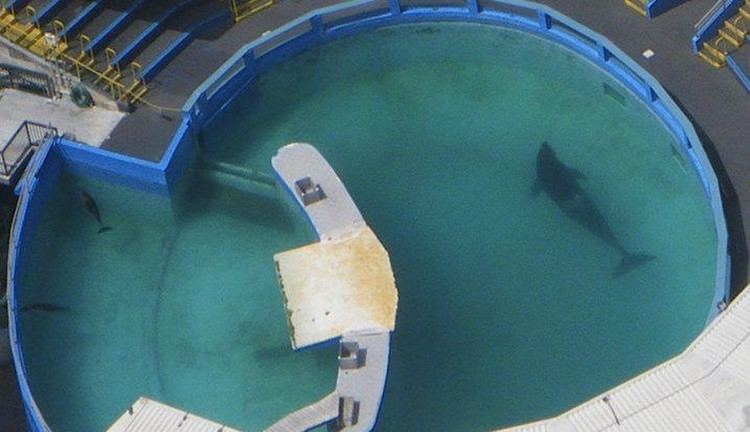 | ||
Lolita is a 20-foot-long (6 m), 7,000 pounds (3,200 kg) orca who has lived at the Miami Seaquarium since 1970.
Contents
Early life
On August 8, 1970 Lolita was caught in Penn Cove, Puget Sound, Washington. She was one of seven young whales sold to marine parks around the world from a roundup of over 80 orcas conducted by Ted Griffin and Don Goldsberry, partners in a capture operation known as Namu, Inc. Tokitae, as she was originally named, was purchased by Seaquarium veterinarian Dr. Jesse White for about $20,000. On arriving to the Seaquarium Lolita joined another Southern Resident Orca named Hugo who was captured some time before Lolita and had lived in the park two years before her arrival. Tokitae was renamed Lolita "after the heroine in Vladimir Nabokov’s novel".
She and Hugo lived together for 10 years in what is known as the Whale Bowl, a tank 80-by-35-foot (24 by 11 m) by 20 feet (6 m) deep. Even though the pair mated many times (once to the point of suspending shows) the two never produced any offspring. Hugo died on March 4, 1980. Since then, Lolita has lived in the Whale Bowl together with a pair of Pacific White Sided dolphins.
Controversy
While Lolita is Seaquarium's main attraction, she has attracted attention from animal rights groups and anti-captivity activists. In 2003 Lolita was the subject of the documentary Lolita: Slave to Entertainment in which many anti-captivity activists, most notably Ric O'Barry (former Flipper trainer), argue against her current conditions and express a hope that she may be re-introduced to the wild. Protesters assert that the Seaquarium is treating Lolita cruelly.
Lolita is approximately 21 feet (6.4 m) long and 7,000 pounds. Per the guidelines, the tank for a killer whale the size of Lolita must be a minimum of 48 feet (15 m) wide in either direction with a straight line of travel across the middle. Lolita’s tank is only 35 feet (11 m) wide from the front wall to the slide out (work island) barrier*. It is 20 feet (6.1 m) deep at the deepest point and a mere 12 feet (3.7 m) deep around the edges.
On January 17, 2015, thousands of protesters from all over the world gathered outside the Seaquarium to ask for Lolita's release, and asked other supporters worldwide to tweet #FreeLolita on Twitter.
Legal cases
In November 2011 Animal Legal Defense Fund (ALDF), PETA, and three individuals filed a lawsuit against the National Marine Fisheries Service (NMFS) to end the exclusion of Lolita from the Endangered Species Act (ESA) of the Pacific Northwest's Southern Resident orcas. NMFS reviewed ALDF’s joint petition, along with the thousands of comments submitted by the public and found the petition merited. In February 2015, the NOAA announced it would issue a rule to include Lolita in the endangered species list. Although the Orca population that she was taken from is listed as endangered, as a captive animal, Lolita was exempted from this classification. This change does not impact on her captivity at Miami Seaquarium.
On March 18, 2014 a judge dismissed ALDF's case challenging Miami Seaquarium's Animal Welfare Act license to display captive orcas.
In June 2014 ALDF filed a notice of appeal of the District Court decision that found the USDA had not violated the law when it renewed Miami Seaquarium's AWA exhibitor license.
